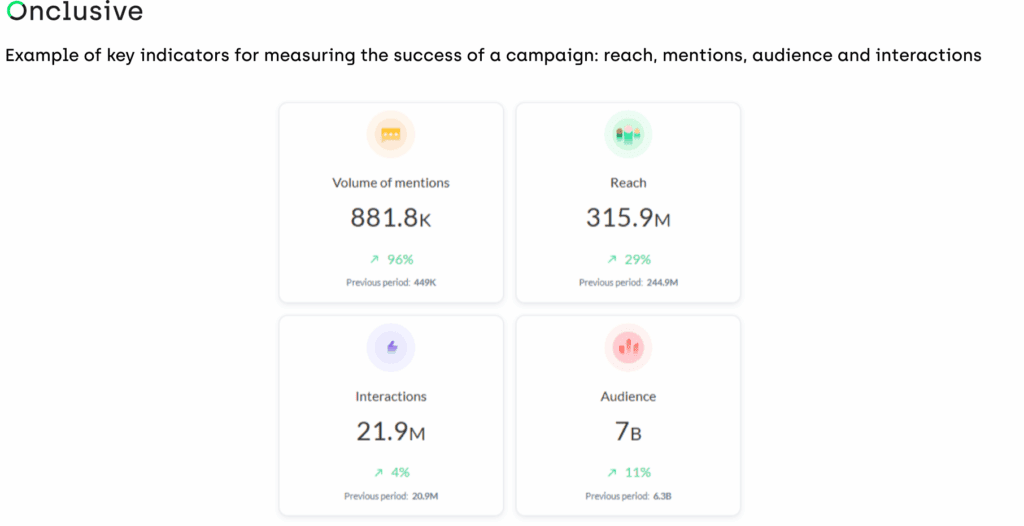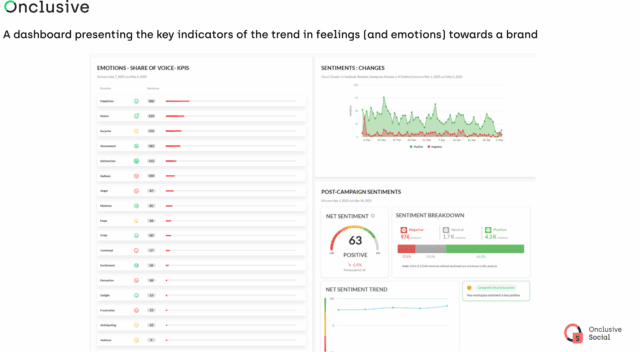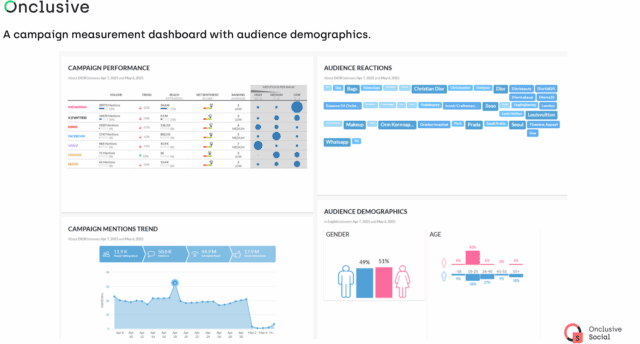Definition:
Key Performance Indicators (KPIs) are measurable indicators that aid decision-making. They are part of a process of continuous improvement and enable the management and monitoring of activities (marketing, social media, PR and Comms in our case). KPIs reported and analysed on a weekly, monthly or quarterly basis. These KPIs are accompanied by targets.
They are therefore based on tangible elements that enable observations to be made, analyses to be carried out and recommendations to be proposed. They are a real help in steering and adapting your strategy.
In the digital marketing world, tracking the success of your communication campaigns is key to understanding what’s working and tweaking your approach. The right Key Performance Indicators (KPIs) act as a compass, guiding your strategy and ensuring you’re achieving the results you aim for. So, what Communication Campaign KPIs should you track to get a clear picture of your campaign’s performance?
Table of Contents:
Key Takeaways – Best Practices for Campaign KPIs
I. How to Align Your KPIs with Your Campaign Goals
II. Monitor the Right Data and Review Regularly
III. Bring All Your Data Together for Actionable Insights
IV. Adapt Your Strategy Based on What the Data Tells You
Key Takeaways – Best Practices for Campaign KPIs
- Align KPIs with Specific Campaign Goals Set clear objectives before launching your campaign and match your KPIs accordingly. For brand awareness, track reach and share of voice; for engagement, monitor likes and comments; for conversions, focus on leads and sales metrics. Using the SMART framework ensures your indicators are meaningful and directly tied to business outcomes.
- Consolidate Data for Real-Time Decision Making Bring all your campaign metrics together in centralized dashboards to visualize performance across platforms. By monitoring media channels, mentions, sentiment, and audience demographics in one place, you can quickly identify what’s working and make informed adjustments without delay.
- Regular Monitoring Drives Continuous Optimization Review your campaign data consistently—daily, weekly, or monthly—to spot trends, understand audience behavior, and identify high-performing content. Regular analysis allows you to pivot strategies in real-time, reallocate budgets to effective channels, and maximize ROI throughout the campaign lifecycle.
- Adapt Strategy Based on Data Insights The true value of KPIs lies in your ability to act on them. Continuously learn from your metrics and adjust messaging, targeting, and budget allocation based on what the data reveals. This iterative approach transforms campaign management from guesswork into a strategic, evidence-based process.
I. How to Align Your KPIs with Your Campaign Goals
Above all, to kick off any successful campaign, start by asking What do you want to achieve? Whether your focus is increasing brand awareness, engaging your audience, or driving conversions, your Communication Campaign KPIs should directly reflect those goals.
- Brand awareness: Track reach, mentions, impressions, and share of voice.
- Engagement: Focus on likes, shares, comments, and click-through rates.
- Conversions: Look at conversion rates, leads generated, and sales metrics.
Having clear goals will also help you set the SMART framework: Specific, Measurable, Achievable, Relevant, and Time-bound. This ensures your KPIs are meaningful and tied directly to your overarching business objectives.

Choose your marketing KPIs according to the nature of your objectives
Case Study: Regional Campaign in Focus
A regional council ran a campaign promoting a new rail line. They measured reach, mentions, and sentiment, identifying which cities were most engaged and which influencers were amplifying their messages. This allowed them to adjust their strategy for even greater impact in high-performing regions.

Example of key Campaign KPIs for measuring the success of a campaign: reach, mentions, audience and interactions . Via Onclusive Social social media listening tool
Key Performance Indicators for Communication Campaign Evaluation
The effectiveness measurement of communication campaigns relies on a strategic set of indicators designed to assess impact and message resonance with target audiences. This multidimensional analysis framework is organized around three fundamental axes and these Communication Campaign KPIs:
a.Reach and Visibility Metrics
- Reach: quantification of audience exposed to campaign messages and official hashtag
- Mentions: volume of campaign references, segmented by channel
- Virality: propagation of high-impact content through sharing behavior
b.Engagement Indicators and Conversational Analysis
- Interaction rate: measurement of engagement generated by content
- Conversational trends: identification of volume peaks associated with specific themes
- Associated terminology: mapping of keywords linked to the campaign
c.Socio-demographic Data and Influence
- User profiles: segmentation by age, gender and professional category
- Sentiment: evolution of positive and negative perceptions
- Voice distribution: allocation of different opinion tones
- Influence networks: classification of ambassadors according to potential audience reach
- Geographic implementation: identification of regional diffusion centers
This evaluation architecture enables granular performance understanding and facilitates tactical optimization of campaigns in real-time. The integration of these metrics provides stakeholders with comprehensive visibility into campaign effectiveness across multiple dimensions, supporting data-driven decision-making processes.
II. Monitor the Right Data and Review Regularly
Then, with your KPIs in place, it’s time to dive deep into the data. Regularly reviewing performance across different periods (daily, weekly, or monthly) ensures you’re not only tracking success but can also optimise in real-time. Here’s what to keep an eye on:
- Audience demographics: Who’s interacting with your campaign? Are you reaching your target audience?
- Community growth: Is your brand gaining visibility and followers?
- Engagement trends: Which parts of your campaign are sparking conversations and driving the most engagement?
Case Study: Retail Brand Maximising ROI
A major retail brand used social listening tools to track the effectiveness of its campaigns in real-time. They monitored sentiment, mentions, and engagement to adjust their content and timing for maximum reach. The ability to respond to trends instantly meant they could keep the conversation going and build a deeper connection with their audience.
It’s essential to identify which elements of your campaign are driving the most impact. This gives you the chance to pivot your approach or put more focus on what’s working.

Campaign KPIs: A dashboard presenting the key indicators of the trend in feelings (and emotions) towards a brand. (via Onclusive Social)
III. Bring All Your Data Together for Actionable Insights
Also, consolidating your data in one place is essential for making fast, informed decisions. Using dashboards to integrate all campaign metrics helps you keep your finger on the pulse of performance. These dashboards allow you to visualise data, compare campaigns, and generate custom reports.
Communication Campaign KPIs to include on your dashboard:
- Media & channels: Which platforms are performing the best?
- Mentions & trends: What are people saying about your campaign?
- Sentiment & emotions: How do people feel about your brand or message?
- Audience demographics: What is the profile of those engaging with your campaign?
Case Study: Fashion Brand Measuring Impact
A fashion brand launched a campaign for their spring-summer shoe collection, starring a popular actor. By using a dashboard to track mentions, engagement, and geographical reach, they were able to identify which countries were most responsive and which influencers were driving the conversation. This gave them valuable insights into which markets to prioritise and how to optimise the campaign’s content for greater impact.
IV. Adapt Your Strategy Based on What the Data Tells You
The key to making KPIs work for you is the ability to adapt. Campaigns evolve over time, and being able to track progress and tweak strategies based on what’s working (or not) is essential. Keep reviewing your KPIs regularly, revisit your goals, and make the necessary adjustments.
The real power of KPIs comes from continuous learning and optimisation. This means adjusting in real-time, whether it’s improving audience targeting, boosting content that’s performing well, or optimising your budget spend.
Case Study: Continuous Campaign Optimisation
A luxury company used social listening and dashboard analytics to measure its campaigns on engagement and conversion rates. By continuously reviewing audience insights and sentiment, they were able to adapt their messaging and reallocate budget to the most impactful parts of the campaign, driving higher conversions with less spend.
A campaign measurement dashboard with audience demographics. Via Onclusive Social
Next Steps…
To truly identify which of your communication campaigns are performing best, setting clear goals and aligning them with the right KPIs is crucial. Regular data analysis, combined with strategic adjustments, will ensure you’re always moving toward success. Consolidating insights into dashboards provides real-time, actionable data, empowering you to make the best decisions for your brand. So, whether you’re tracking reach, engagement, or conversion, the right KPIs will help you navigate the landscape and drive better results.
Ready to take your social media strategy to the next level? Don’t wait to enhance and support your Social Listening analyses with artificial intelligence-powered functions.
Frequently Asked Questions about Campaign KPIs
Q: What are KPIs and why are they important for communication campaigns?
Key Performance Indicators (KPIs) are measurable metrics that help you track and evaluate the success of your communication campaigns. They’re important because they provide tangible data to understand what’s working, guide strategic decisions, and demonstrate ROI. KPIs transform subjective impressions into objective insights, enabling continuous improvement and helping you achieve your specific campaign goals more effectively.
Q: How do I choose the right KPIs for my campaign?
Start by defining your campaign objectives clearly. If you’re focused on brand awareness, track metrics like reach, impressions, and share of voice. For engagement goals, monitor likes, shares, comments, and click-through rates. For conversion-focused campaigns, measure conversion rates, leads generated, and sales. The key is ensuring your KPIs align directly with what you want to achieve and follow the SMART framework—making them Specific, Measurable, Achievable, Relevant, and Time-bound.
Q: How often should I review my campaign KPIs?
The frequency depends on your campaign duration and goals, but regular monitoring is essential. Daily reviews work well for time-sensitive or rapidly evolving campaigns, while weekly or monthly analyses suit longer-term initiatives. The important thing is consistency—establish a review rhythm that allows you to spot trends, identify issues early, and make timely adjustments. Real-time dashboards enable you to monitor critical metrics continuously while conducting deeper analyses at set intervals.
Q: What tools can help me track and measure campaign KPIs effectively?
Social listening and analytics platforms like Onclusive Social provide comprehensive dashboards that consolidate data from multiple channels in one place. These tools track metrics such as reach, mentions, sentiment, engagement rates, and audience demographics while offering visualization features for easier interpretation. The best tools integrate data from various sources (social media, PR, web analytics) and provide real-time insights, allowing you to monitor performance, generate custom reports, and make data-driven decisions quickly.


